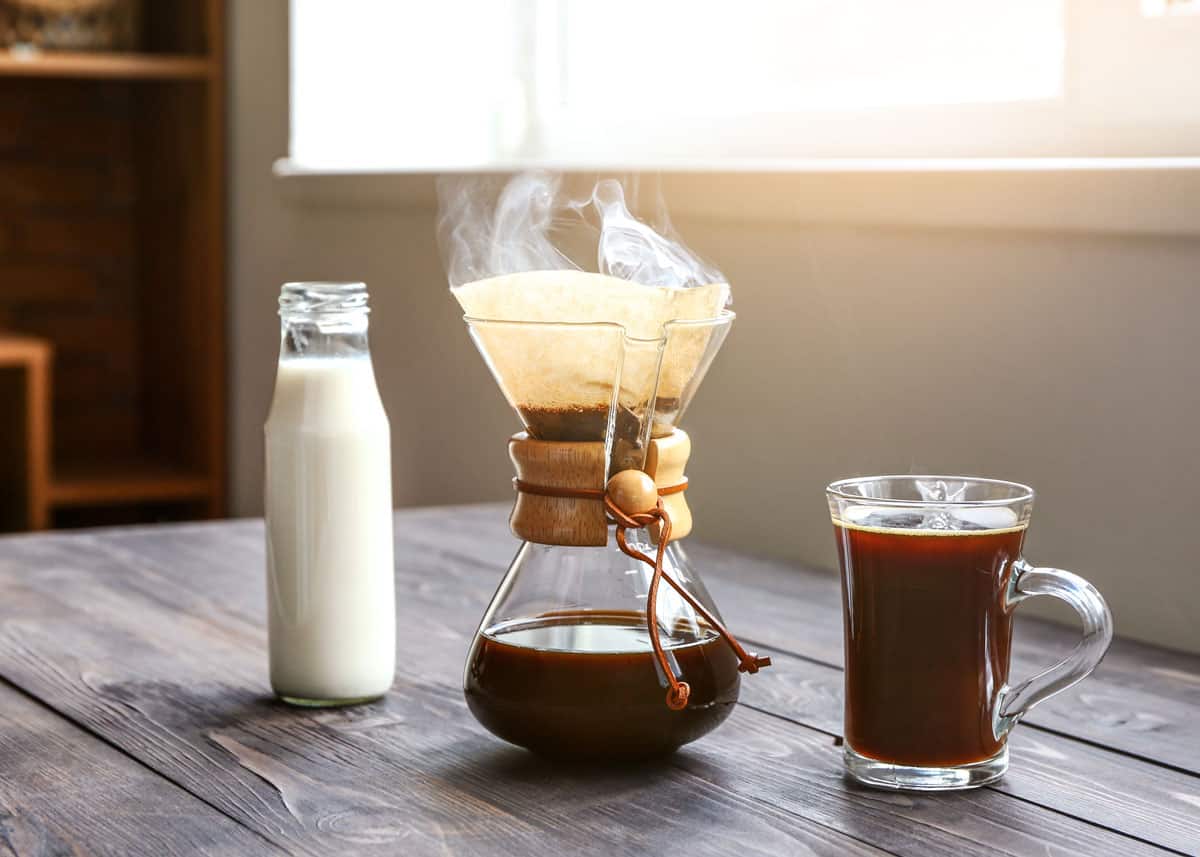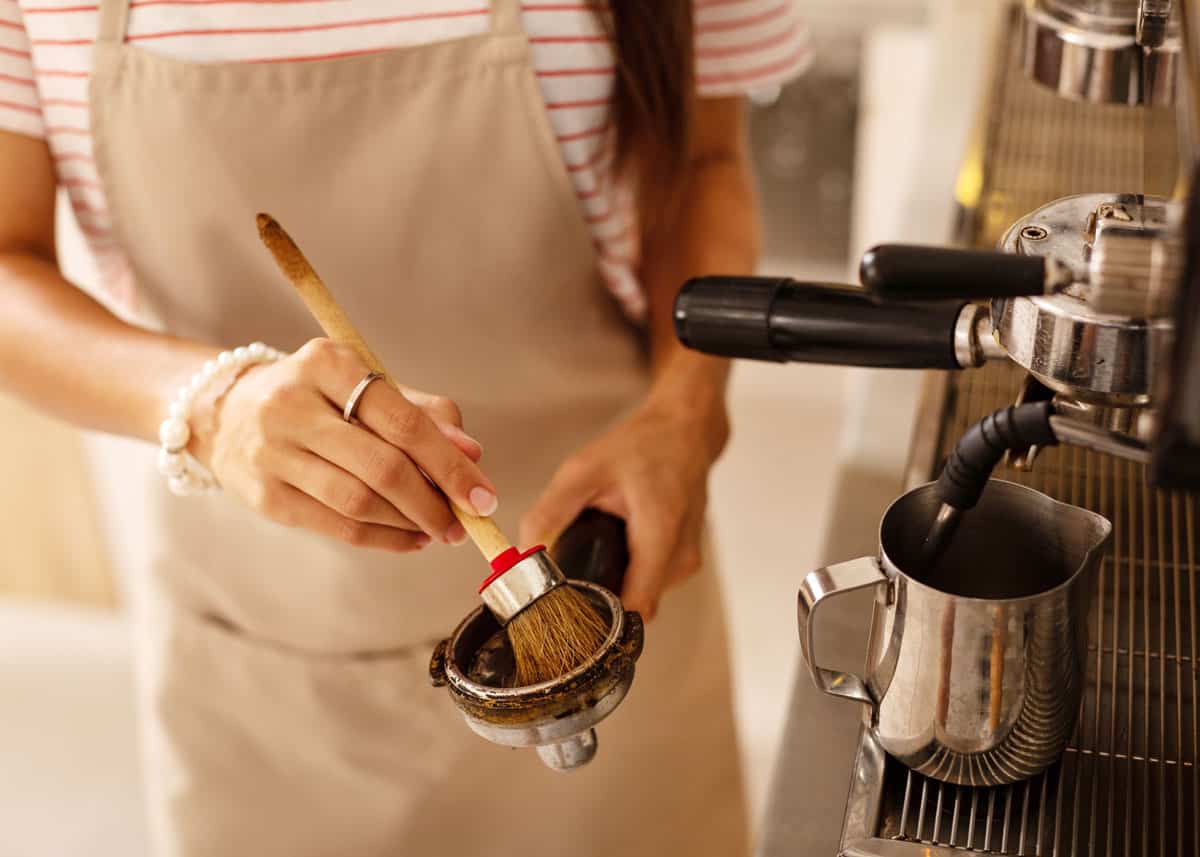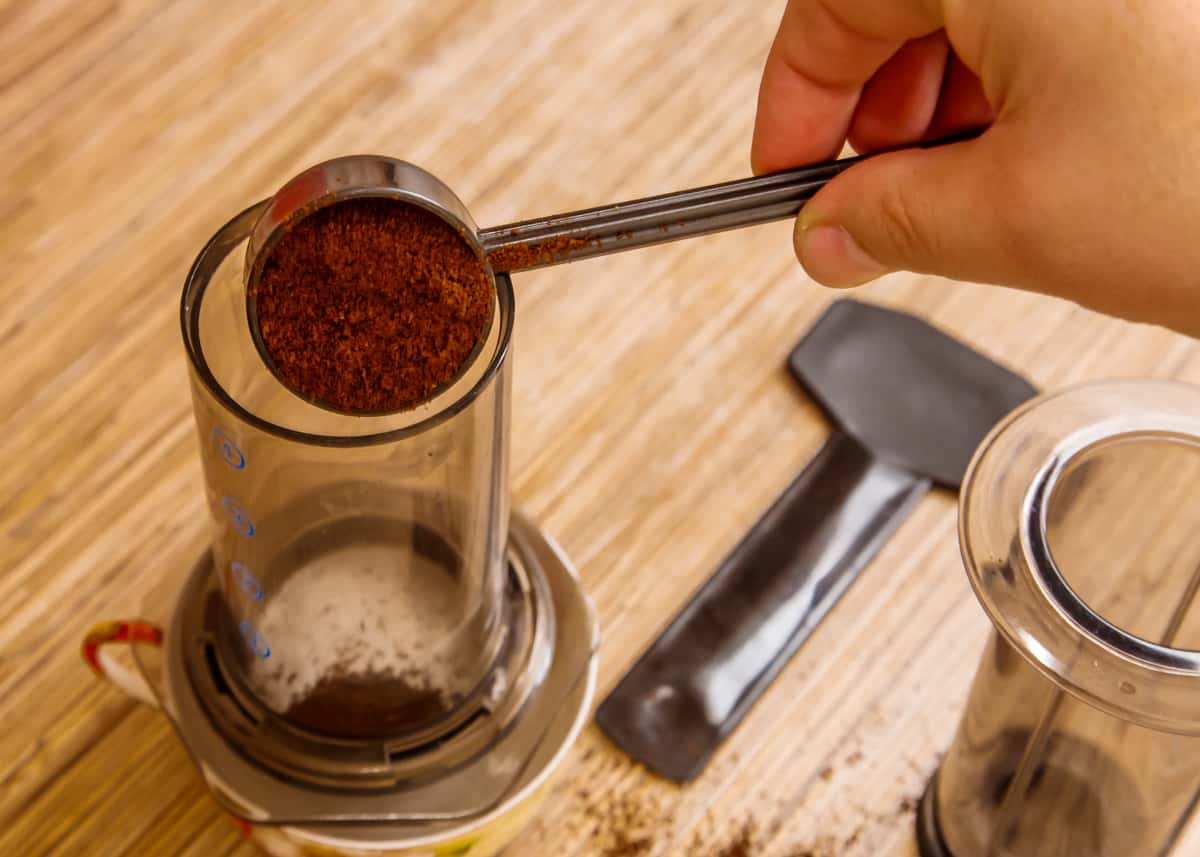Figuring out how to clean a coffee maker can be a little tricky. Some makers are complicated with a lot of parts, and others are simple but delicate. In this post, you’ll see that keeping your coffee maker clean can extend its life, keep your coffee tasting great and maintain your health.
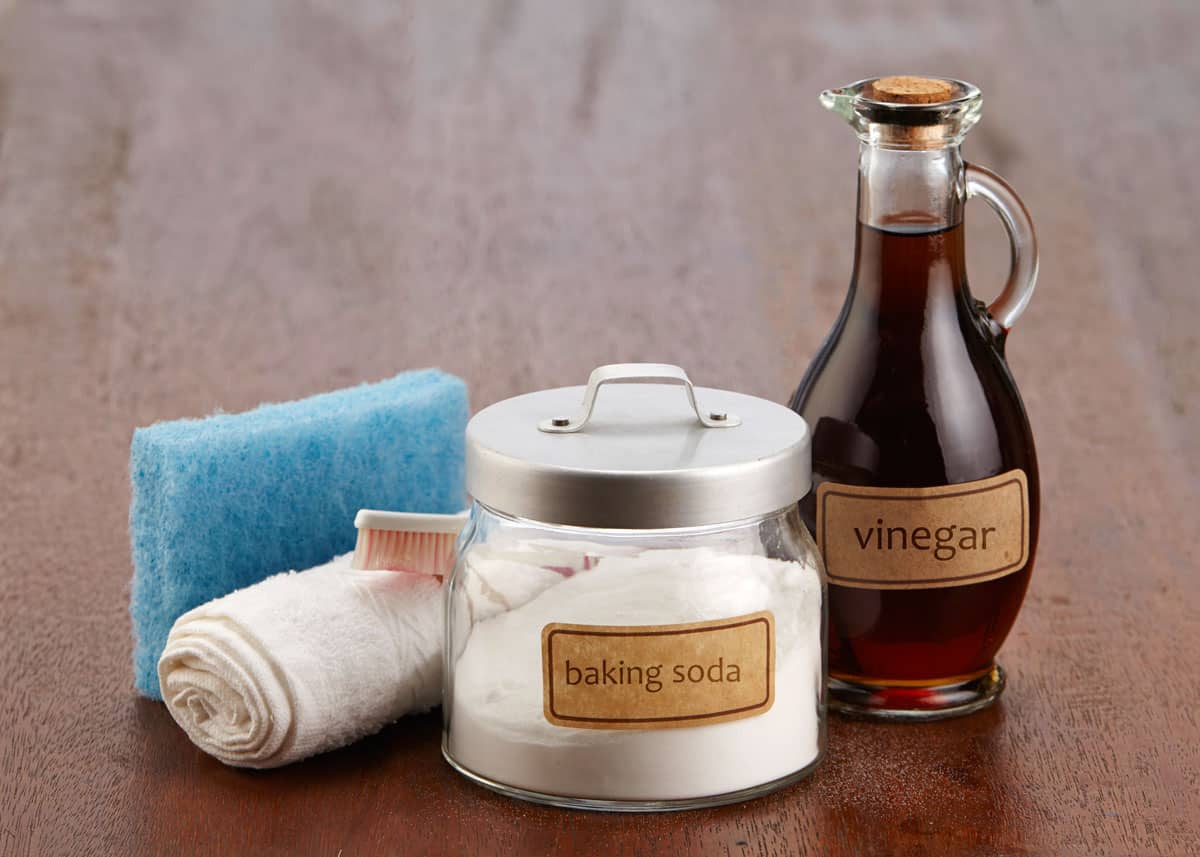
Table of Contents
What is the best way to clean a coffee maker?
What’s the best way to clean your coffee maker? If you only ever clean your carafe, you’re probably in for a big surprise. And unless you only drink instant coffee, cleaning your other coffee gear is important to the quality of your coffee.
Coffee makers can grow mold and yeast colonies because of the warm, wet interior, and just cleaning the carafe isn’t enough to handle everything.
We’re going to show you how to clean your coffee maker thoroughly and adequately. Your coffee will flow faster, taste better, and won’t make you sick.
Let’s take a look at all the ways you can keep your coffee maker clean so no matter how you brew your coffee it will taste great.
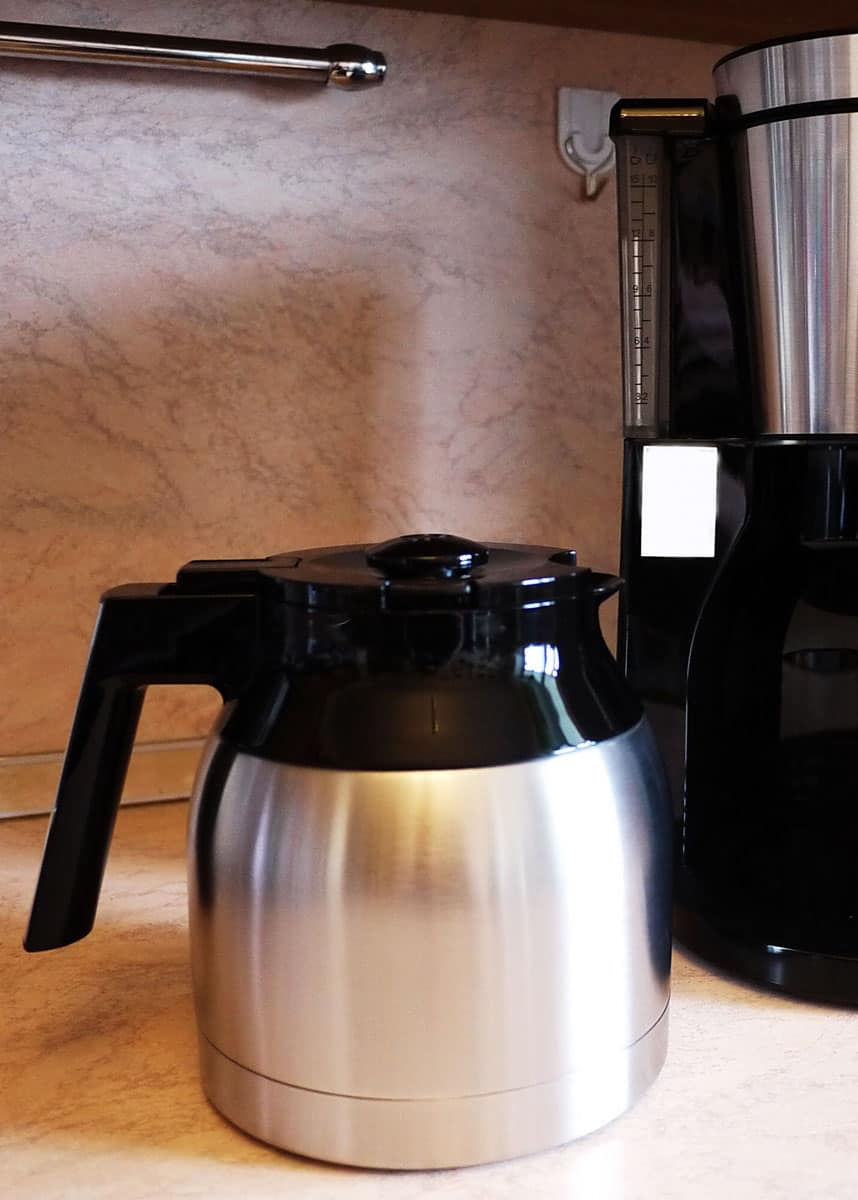
Most of us just stick the carafe in our dishwashers and call it a day. But what about the coffee maker itself?
The parts that you don’t see are the ones that can harbor bacteria and mold because they are dark and moist which makes for a great breeding ground.
In addition to how you store your coffee, how you clean your coffee machine can help you ensure your coffee stays fresh and healthy.
To take care of everything you may need to clean out your coffee maker in a few different ways.
Depending on the model, different techniques are used to descale, de-clog, and de-mold your unit. Make sure you follow the unit’s instructions completely and consult appropriate videos on youtube if you need help troubleshooting.
Also, check the warranty because you could invalidate it by using something other than what’s recommended to clean it.
The manufacturer is also a valuable resource, so checking their site for tips (or calling customer service) may help you find techniques for getting the machine clean.
If you have a complicated machine like an espresso machine, take the time to learn how to disassemble it safely so that you can clean it more thoroughly. Each piece that can be removed brings you one step closer to ensuring your machine is completely clean and sanitized.
Basic Way to Clean a Coffee Maker
The most basic way to clean a regular household drip machine is to:
- Brew some water: Run plain hot water through the maker to get out any lingering debris. The hot water will help strip away some of what could be making your coffee maker a breeding ground for mold.
- Brew some vinegar: Once you’ve run a clean cycle through, you can add vinegar (a 1:1 vinegar to water ratio is good unless your maker calls for less vinegar, it’s always best to check the manual if you still have it) and run the mixture through for a cycle to kill mold and further strip away any film. The film is sticky and can help trap bacteria exactly where you don’t want it.
- Brew some more water: Run one or two more clean cycles of plain water through just to be safe.
- Allow to dry: Once you’ve flushed the inside of the coffee maker, you’ll want to leave it open to allow it to dry completely. Once that’s done, wipe down the outside and make sure you’ve gotten around any buttons or knobs where you push regularly.
It’s important that you follow those steps so that you don’t inadvertently consume any mold or bacteria.
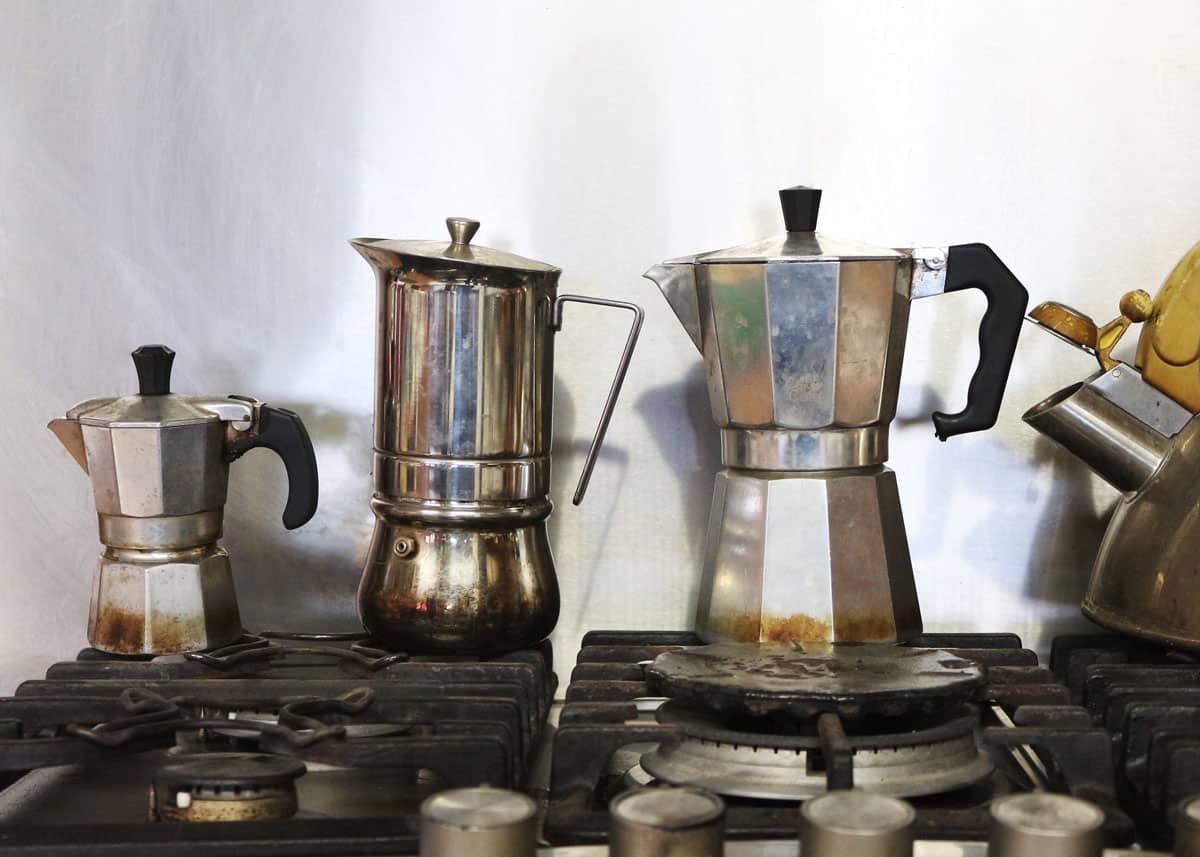
How often should you clean your coffee maker?
Many people don’t clean their coffee maker nearly enough. Some need to be cleaned after every use.
The frequency with which you wash your coffee maker depends on what kind you’re using (more on that below). But for an ordinary household electric coffee maker, you should wash it at least once a month.
Each time you brew coffee, deposits can begin to build up inside the machine causing grime and brewing issues. You may notice your coffee maker running slowly or that the coffee doesn’t taste quite right no matter what you do.
Cleaning your coffee maker regularly helps to refresh the machine and prevent build-up from attracting mold and bacteria.
Sometimes people throw out perfectly good machines just because the flow stops working correctly or the coffee tastes wrong when all that’s needed is a thorough cleaning.
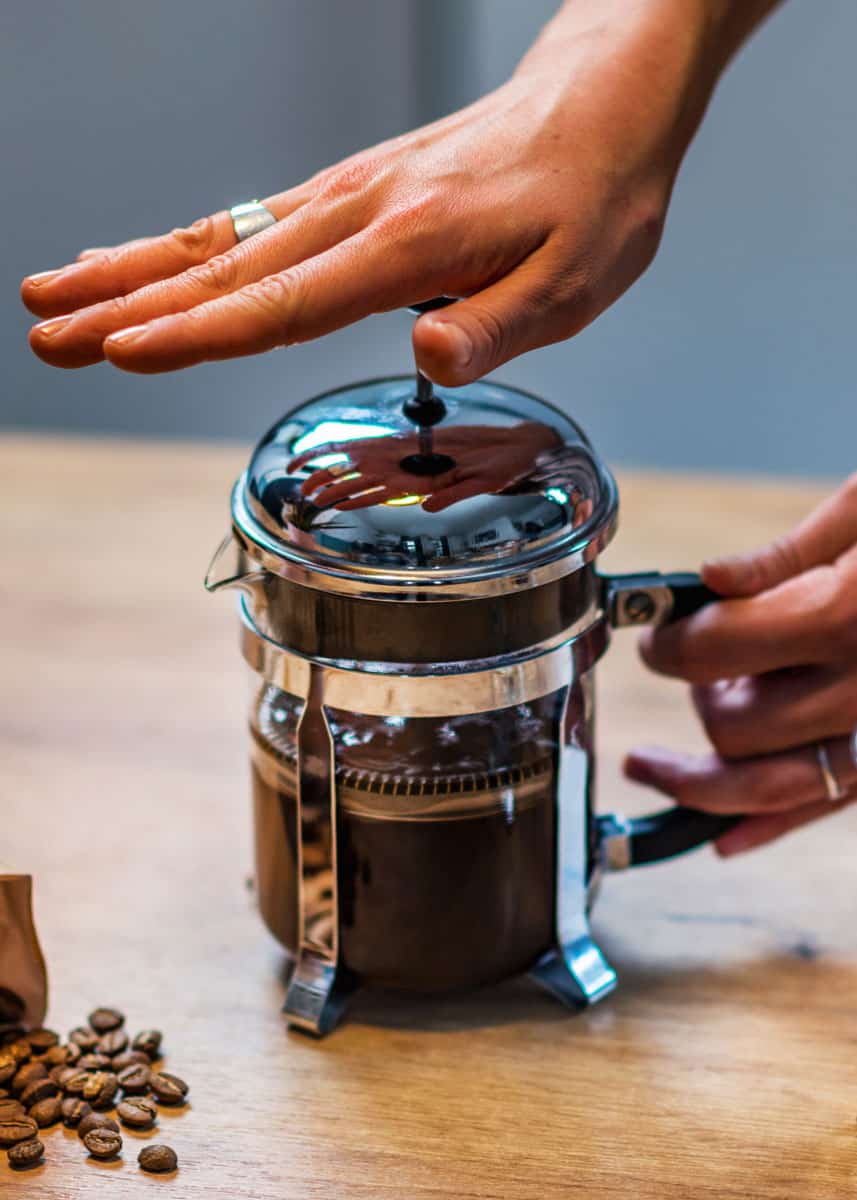
What about a french press or Chemex…?
You should hand wash any coffee maker that doesn’t run on a drip.
If you’ve got a french press or Chemex, for example, those should be cleaned thoroughly every time you make a cup of coffee because grime (oils and grounds) can collect on the walls of your carafe and negatively affect your coffee.
And the Moka pot or Percolator…?
Makers that go on the stove should also be cleaned after every pot to prevent build up.
Percolators and Moka pots can create a burnt on coffee grime if you don’t wash them regularly. This can cause staining that’s nearly impossible to get out, and negatively affect the flavor of your coffee.
Cleaning regularly can prevent staining (although some amount of staining is inevitable and normal) and keep your coffee tasting great.
Cleaning metal can be tricky, so make sure you’re using cleaning materials that are nonabrasive and won’t cause rust or scratch the surface of the metal. Metal can degrade over time if the finish is damaged, which is another reason you want to make sure to clean the maker regularly.
If the grime stays on for a long time, it can eat away at the finish. Once it starts, there isn’t anything you can do for the maker.
Follow the manufacturer’s instructions and try to get into a regular cleaning routine. Cleaning it more often reduces the time you spend because you won’t have set-in grime and tough to remove stains.
The coffee maker will last longer and your coffee will taste better.

Interested in a specific brand of coffee maker? Here’s how to clean your coffee maker – by brand (including Ninja, Bunn, Bella, Keurig, Cuisinart, Mr. Coffee, and Black & Decker for better-tasting coffee.
9 Reasons to Regularly Clean Your Coffee Maker
Still not convinced? It may be helpful to know that a couple of things about coffee taste quality that is often overlooked are how long coffee lasts and the need to keep coffee gear nice and clean.
Here are nine excellent reasons to clean your coffee maker regularly.
- Grime traps bacteria. The film that develops from brewing coffee is highly attractive to bacteria. If your drip coffee maker isn’t clean, it can harbor colonies of bacteria within the walls of the maker where they can multiply. Each time you brew coffee, some of that bacteria gets washed into your coffee which isn’t hot enough for long enough to kill all of them.
- Grime encourages mold. The filth is also a perfect host for mold growth. Once again, all you need is a dark, moist place and mold is ready to go. Just brewing coffee doesn’t keep the environment hot enough to kill all the mold spores, increasing the chances you’ll end up with them in your coffee.
- Your drip coffee maker may run more quickly without grime blocking the water flow. As the film builds up inside the coffee maker, it restricts the flow of water, making that morning cup take forever. Cleaning it out restores the original flow of the water and makes sure nothing is blocked.
- Your coffee will taste better. The buildup can also affect the taste of your coffee. In addition to choosing quality arabica coffee, cleaning and decalcifying your machine with vinegar removes any build-up that can change the taste of your coffee and gives it a brighter, cleaner mouthfeel.
- It’s easier to clean regularly. If you wait several months before trying to clean your coffee maker out, the stains and film may be significantly more difficult to remove. Cleaning your coffee maker often and regularly helps prevent those stains and makes cleaning go a lot faster.
- Your machine will last longer. You just bought your coffee maker, but the longer you allow grime and calcium deposits to interfere with your machine, the more likely you are to ruin it well before its expected life span. Cleaning it regularly helps prolong the life of your gear, saving you money and time shopping for replacements.
- You won’t gross out your guests. You may be used to the film on your Chemex, but your guests aren’t. Brewing coffee in what looks like a dirty coffee maker is a great way to ruin any guest’s experience. Make sure it’s all clean before your guests ever arrive.
- It can help keep you healthy. The coffee cycle and even just a plain hot water cycle isn’t enough to clean bacteria. You have to clean it out using other methods, or your coffee maker won’t be nearly as clean as you think. It may not even be enough to entirely kill mold spores, which can make their way into your coffee and make you sick.
- Your coffee will taste the way it should. This is different than just tasting better. Aeropress makers, for example, produce a cup with low acidity, but with build up over time, the acidity can be altered to feel more like a french press. Making sure your coffee maker is clean keeps the benefits of having different brew methods, and tasting different types of coffee.
Getting your coffee maker completely clean is the priority, and it’s going to depend a lot on what the manufacturer recommends and how many different removable components there are.
Let’s take a look at how to clean each type of coffee maker, a few common ways to clean particular brands, and what to do with all those accessories.
Keep reading: How to Clean a Coffee Filter
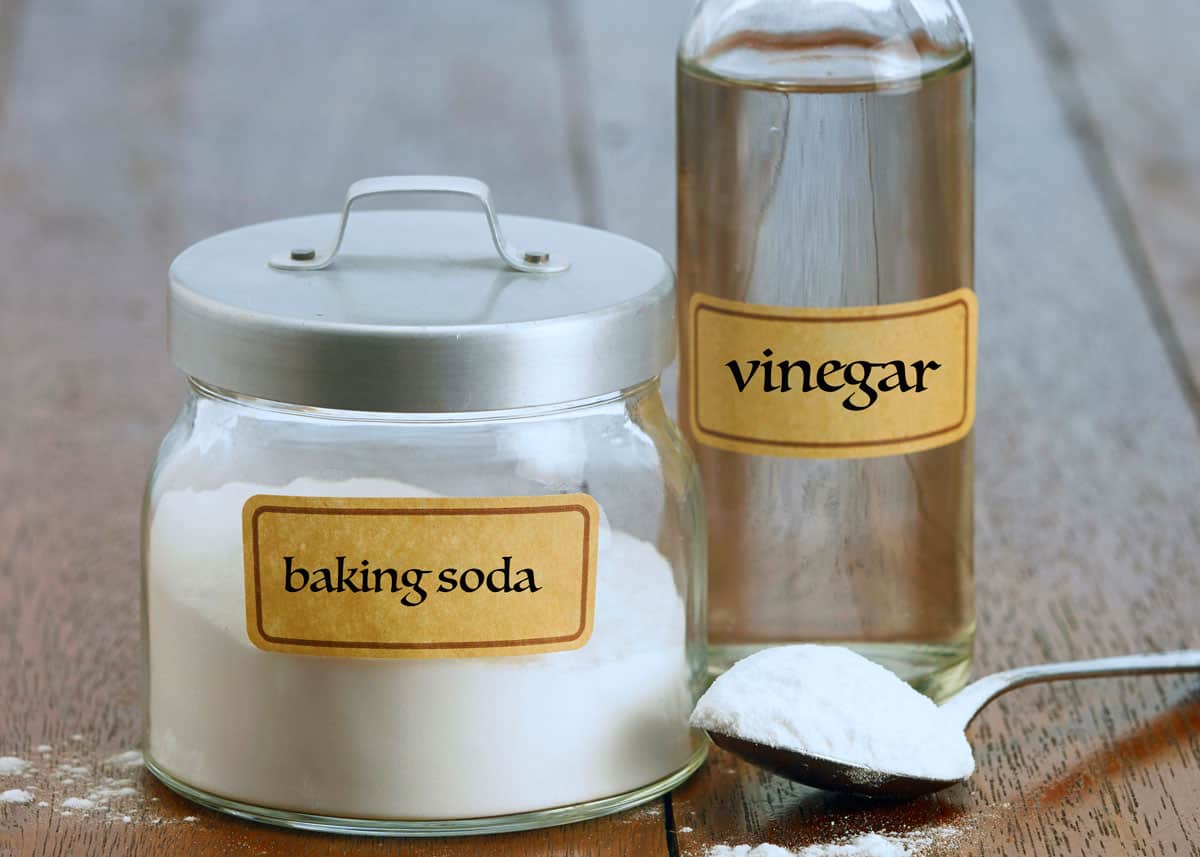
How to Clean a Coffee Maker: 10 Makers
We’re going to get into the specifics of how to clean some of the most popular coffee makers.
It’s best to be familiar with what the manufacturer says so that you can steer clear of problems and keep your warranty intact.
As always be careful with abrasive cleaners. Backing soda is generally fine when mixed with a little water and used gently on stainless steel, but we don’t recommend it with other metals like aluminum.
1. How to Clean a Drip Coffee Maker
Drip coffee makers can hide bacteria and mold in their hidden components. Cleaning a drip requires you to reach those places.
Supplies:
- hot water
- vinegar
- mild soap
- washcloth
Steps to clean a drip coffee maker:
- Run a cycle with plain water. Discard.
- Run a cycle with water and equal part vinegar. Discard the solution.
- Run a couple more cycles with plain water to make sure you rinse all the vinegar out of your machine.
- Remove your carafe and hand wash or place in the dishwasher.
- Wipe down surfaces with a gentle soap or a cleaning wipe.
- Leave the carafe and coffee maker open until completely dry.
Tips for cleaning a drip coffee maker:
- Make sure you run a follow-up brew of hot water to flush out any remaining vinegar. Otherwise, you may get an unpleasant surprise in your next cup of coffee.
- If it’s been a very long time since you’ve cleaned out your coffee maker, you may want to repeat these steps a few times until the water runs completely clear.
- The vinegar solution is critical here to kill bacteria and mold.
2. How to Clean a French Press Coffee Maker
You can take your French Press entirely apart and put many of the components in the dishwasher.
Supplies:
- gentle cleanser
- dishwasher
- hot water
- washcloth, nonabrasive scrubby pad
Steps to clean a french press:
- Slide the glass carafe out of the metal handle if possible and run it through the dishwasher. (If this doesn’t remove all the film, try including the carafe in the following steps.)
- Clean the filter components by twisting until they come off the plunger. If you need to soak the filter, do so.
- Gently scrub (with a nonabrasive scrubby pad, or toothbrush) the elements until all pieces are clean. For stubborn bits, boiling in water for a few minutes can help loosen the grime.
- Assemble the pieces together, and you’re ready for your next cup.
Tips for cleaning a french press:
- Empty grounds as soon as you’re done with the coffee or you could be looking at a molded mess the next time you want to brew coffee.
- Cleaning after every use is essential so grime does not build up in your carafe.
3. How to Clean a Pour Over Coffee Maker
Pour-over coffee makers are pretty simple to clean because they don’t have a lot of moving parts or separate components, but they still need to be cleaned regularly.
Supplies:
-
- gentle cleanser
- water
- denture tablet
- washcloth, bottle-brush/toothbrush
Steps to clean a pour-over coffee maker:
-
- Clean your pour-over maker with your mild detergent, using a bottle brush or toothbrush to gently scrub the surface could be all you need to lift the stains. If you need something to remove grime build-up, a denture tablet can help lift that grime without scrubbing.
- Fill a bowl with water and add one or two tablets into the water. Leave the pour-over coffee maker in the bowl overnight to clean.
- In the morning, remove the pour-over coffee maker and wash gently with detergent and water. Allow to dry completely.
Tips for cleaning a pour over:
- It may help to invest in a small bottle-brush or use a toothbrush.
4. How to Clean a Chemex Coffee Maker
The Chemex is a great coffee option, and easy to clean if you know what to do. Here’s how to get it sparkling again.
Supplies:
-
- mild detergent
- hot water
- washcloth
- denture tablet
Steps to clean a Chemex:
-
- Remove the wooden grips and the leather band.
- Handwash the Chemex in hot water and mild detergent. Make sure the glass comes clean.
- If there’s still a film, fill the Chemex with hot water and add two denture tablets (one if your Chemex is a personal size). Leave overnight.
- In the morning, discard the water inside and thoroughly wash again with soap and hot water. Allow the Chemex to dry completely.
- Replace the grips and the leather strap.
Tips for cleaning a Chemex:
- Removing the sleeve is essential if you’re putting the machine in the dishwasher.
- If you’re washing your Chemex after each use but can’t get your hand inside try putting hot water and a little dish liquid, along with the dishcloth in the bottom and giving it a few good swirls (holding it around “the neck” with both hands).
- Make sure to rinse it thoroughly with clear hot water.
5. How to Clean a Cold Brew Maker
Making cold brew is getting more and more popular. It’s a great way to make iced coffee and many find it easier on their stomach than hot brewed coffee.
Cold-brew makers are basically a pitcher with gadgetry on the inside that allows you to brew the coffee long and slow.
It’s essential to clean your cold brew machine even though it spends most of its time in the fridge because bacteria and mold can still grow even in cold places.
Supplies
-
- mild soap
- water
- washcloth, scrub brush/nonabrasive scrubby pad
Steps to clean a cold brew maker:
-
- Remove the filter components and scrub the pitcher with soap and water, making sure to remove any deposits and build up.
- Scrub the filters just like you would a French Press. Make sure you take them apart and scrub each one individually.
- Allow them to dry completely before reassembling so that they don’t trap moisture.
Tips for cleaning your cold brew maker:
- Pour your cold brew into a different container and remove the coffee grounds as soon as it’s done brewing. This way you won’t get mold in the filter, and you can clean it up right away.
6. How to Clean a Coffee Percolator
Percolators can be fun to watch and are a great way to brew coffee. To keep them working their best they need to be cleaned, and each component scrubbed.
Supplies
-
- water
- washcloth, scrub brush
- mild soap
- baking soda (not for use on aluminum)
- vinegar
Steps to clean a coffee percolator:
-
- Take out the components and start with the pitcher part. Clean the inside thoroughly with your brush until the grime comes clean.
- Clean each part of the brew function. Make sure you get into the filter portion with your brush because grime can build up there as well.
- If you have stubborn stains, fill the percolator with water and add three tablespoons of baking soda (only use baking soda on stainless steel). Run it just like you would when you’re making coffee.
- Allow the water to cool off and rinse out any lingering baking soda.
- Run another cycle of equal parts water and white vinegar. Discard the water and run another cycle of plain water through to remove any residue.
- Clean your components again with mild soap to remove any last traces of grime. Cleaning your percolator more regularly will help prevent having to go through each of these steps every single time you do it.
Tips for cleaning your coffee percolator:
- Clean it every time you use it. We know you don’t want to, but it will be so much simpler if you do.
- If you’re using an electric coffee percolator be careful not to get water on the electric contacts on the bottom of your pot.
7. How to Clean an Espresso Machine
Espresso makers are a little more complicated to clean, but if you want to keep making that perfect cup of espresso, make sure you clean your machine and all its components.
Here’s what you’ll need for basic cleaning. Consult the manual for a more thorough cleaning. Your model may have specific requirements different than the standard.
Supplies
-
- hot water
- mild soap/chemical appropriate for your espresso machine
- cleaning brush
- steam wand cleaning brush
Steps to clean an espresso machine:
-
- Scrub the screen by gently scrubbing it until there are no lingering coffee grounds or films. Sometimes you’ll want to remove the screen to clean the water jets themselves.
- Backflush the machine. Put the blind filter into your portafilter and run water (without coffee) as usual for 5-second intervals, each time dumping out the dirty water. Repeat about 5 times.
- Allow the water to release into the drip tray and fill the portafilter with your mild soap.
- Repeat this step several times to remove all the soap and make sure any lingering coffee oils are removed.
- Brush the basket out. Remove the basket from the portafilter and run it under hot water while scrubbing out with a brush.
- Clean out the steam wand thoroughly with your wand tool. The best thing to do is to clean it each time so that milk doesn’t burn to the surface.
The following video will show these steps:
Watch on YouTube
Tip for cleaning your espresso machine:
- Learning how to disassemble the machine is key to getting it thoroughly clean. Consult your owners’ manual, contact the manufacturer and watch videos if you need to.
8. How to Clean a Stovetop Espresso Maker (Moka Pot)
A Moka pot is a popular way to make coffee while camping, and for those who just love a strong cup. We take ours camping and my husband uses his every day at home.
As with a coffee percolator, you’ll want to take the components of your Moka pot apart and clean them with a good brush.
Not cleaning the components regularly can lead to permanent staining, damage in the metal finish, and grime that’s impossible to get off. Make sure you wash your pot after each use to keep your coffee tasting its best.
Again only use baking soda on stainless steel.
Supplies
-
- hot water
- washcloth, cleaning brush/nonabrasive scrubby pad
- mild soap
- baking soda (for stainless steel only)
Steps to clean a Moka pot:
-
- Take all the components separately and clean them with soap and water.
- Lingering stains can be cleaned out using soap with a little baking soda. Be careful not to scrub too hard. Do not use baking soda unless your Moka pot is stainless steel. A nonabrasive scrubby pad with a little mild soap may be all you need
- Make sure the components are completely dry before assembling, especially if you plan to store the espresso maker for a while.
The following video will show you how to clean the gasket and interior of the Moka pot. Cleaning the rest of the machine is pretty straight forward.
Watch on YouTube
Tips for cleaning a Moka pot:
- Make sure you clean the machine each time you use it so you don’t get scorch marks and hard to remove oil stains.
- About once a week remove the gasket and filter and clean them along with the interior of the machine (as shown in the above video).
- Dump out the coffee grounds as soon as the pot cools down. Grounds left in a Moka pot will mold and damage the seal.
9. How to Clean an Aeropress Coffee Maker
The Aeropress is known for milder, less acidic coffee and faster brew times. Make sure it stays that way with regular cleaning.
Supplies:
-
- soap
- water
- washcloth, brush
Steps to clean an Aeropress coffee maker:
- After each use, remove the plunger and pop out the filter. Remove any condensed grounds.
- Rinse out the coffee maker and carefully clean the rubber stopper that helps seal the grounds.
- Clean the body of the press with gentle soap and water to remove any lingering residue. Make sure you rinse out any soap thoroughly.
Tips for cleaning an Aeropress:
- Aeropress will turn acidic if not cleaned after each use. If your Aeropress coffee tastes funny, you probably aren’t cleaning it enough.
10. How to Clean a Metal Coffee Urn (stainless steel)
Metal urns are subject to scorch stains if you don’t continually clean the film from the inside. Make sure you don’t ruin the finish by leaving that film to eat away at the surface.
Supplies:
-
- soap
- baking soda
- water
- washcloth, brush/nonabrasive scrubby pad
Steps to clean a metal coffee urn:
- Fill the pot with water and three tablespoons of baking soda (we don’t recommend using baking soda on aluminum). Again try a nonabrasive scrubby pad with some mild soap first.
- Gently scrub the film with your brush until it comes away from the surface.
- Rinse out the coffee pot and wash it with a gentle soap to remove any lingering stains and baking soda.
- Pour boiling water into the pot and allow it to sit until cool. Leave the urn open until it’s completely dry.
The following video shows a no-scrub method.
Watch on YouTube
Tips for cleaning a metal coffee urn:
-
- Clean the urn gently but regularly.
- Make sure it is well rinsed (free of soap residue) and dry before the next use.
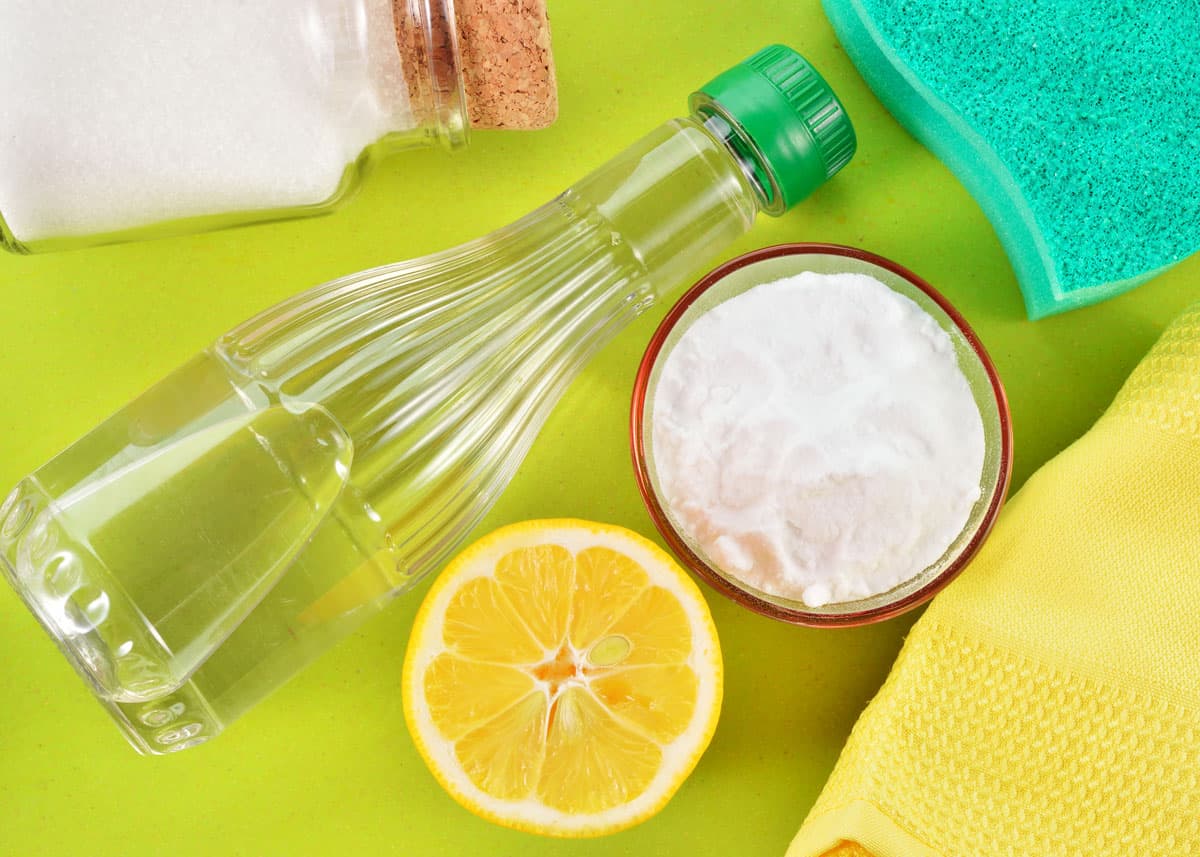
Trouble Shooting When Cleaning a Coffee Maker
Let’s take a look at how to solve a few issues you may have if you’re cleaning your coffee maker for the first time.
How do you clean a moldy coffee maker?
You can help kill mold by using a mixture of hot water and vinegar (equal parts, so half water, half vinegar should do the trick).
You may have to run several cycles of vinegar solution to completely remove the mold.
If the machine is too moldy it may be best to throw out the coffee maker and start over.

How do you clear a clogged coffee maker?
Clogged coffee makers are often the result of grime and grounds building up in the basket or water jets.
Use a small brush and knock free any grounds you see in the basket. Even better if the basket is removable and you can turn it over and gently tap it on the counter (or in the sink) to help dislodge the grounds.
Run a cycle of water and vinegar to help loosen any grime that may be causing grounds to stick to the surface of the basket.
If this does not do the trick you may need to dismantle your machine a little and clean out the water jets, consult the manufacturer for anything that seems too complicated.
Does vinegar kill mold in a coffee maker?
A strong enough concentration of vinegar will kill mold lingering in your coffee maker. White vinegar is best for this type of job.
If your coffee maker has visible patches of mold, you may want to run one part water to three parts vinegar, brushing out the basket and drip section after each part.
Once you’re sure the mold is gone, run several cycles of just water to clean out the vinegar smell and taste.
If in doubt it may be best to get rid of the coffee maker and start with a new one.

Cleaning Coffee Mugs and Thermoses
How do you clean a stainless steel coffee decanter?
Stainless steel is easy to clean. Use a mixture of mild dish soap and baking soda with hot water to gently scrub out any film and residue.
If you’re concerned that backing soda will damage the finish try a nonabrasive scrubby pad instead, but you’ll still need to use a light touch.
Make sure you do this after each use to prevent the stains from setting in or ruining the finish of your decanter. It’s essential that your decanter remains free of residue that can contaminate your coffee with mold or bacteria.
How do you clean a stainless steel coffee mug?
Some stainless steel can go in the dishwasher, but double-walled mugs cannot.
We recommend hand washing regardless of whether it can go in the dishwasher using the same method above to remove any residue and grime.
Make sure you store the mug with the top unscrewed so any moisture can dry thoroughly. Otherwise, you may end up with mold.
How do you clean a metal thermos?
Metal thermoses must be hand washed.
Use a long scrub brush to reach down inside with a mixture of soapy water and vinegar to sanitize.
Be sure you rinse thoroughly, you can use a light to peer inside to makes sure all stains are taken care of completely.
Clean your thermos after each use to make this process a lot easier.

More reading: Coffee Maker Cleaner Guide: 12 Healthy Coffee Tips
How Will You Clean Your Coffee Maker?
Hopefully, this answered your questions about how to clean a coffee maker – no matter what type of machine you have right now.
Taking the time to clean it gives you better, healthier coffee and a longer life span from your machines.
Don’t rely on just the hot water cycle to make sure it’s clean.
Take the time to scrub and descale components gently, and unclog drips and filters for the best coffee results.
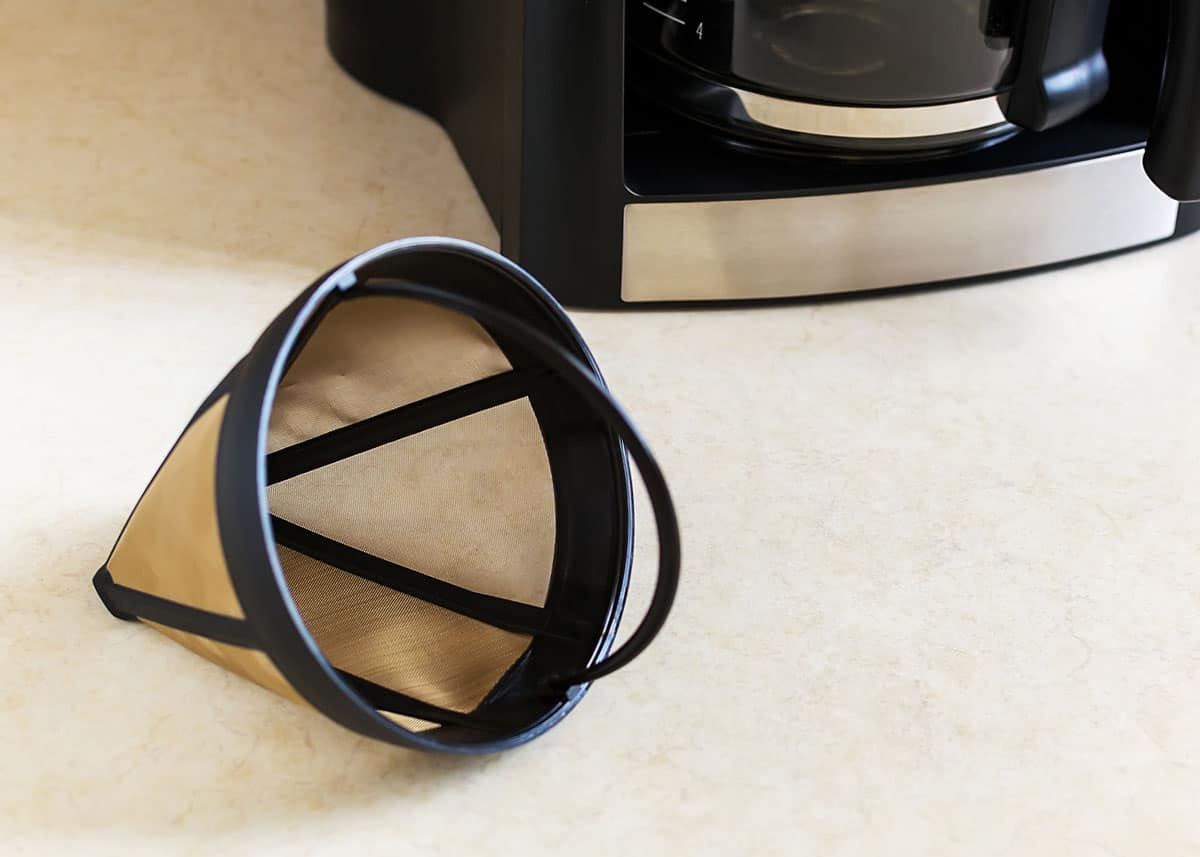
Your Turn
I would love to hear what works best for you, please share your thoughts and tips by commenting on this post.
- About the Author
- Latest Posts
Dena Haines is a co-founder and blogger on EnjoyJava – and is working to make it the best coffee blog in the world.
She also blogs about travel at Storyteller.Travel and photography at Storyteller Tech. Dena is a partner at Storyteller Media, a publishing company she started with her husband, Bryan.

